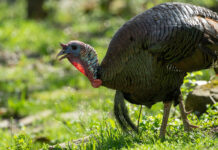
For most, especially those of us with livestock, winter offers a sweet reprieve from the annoying insects that can drive us and our animals crazy with their incessant pestering and biting. Yet, unbeknownst to many, the insect world is actually alive and well during the colder months, and all you have to do is look around to see that insects and other arthropods are everywhere. Spiders, stoneflies and moths, to name a few, can be seen going about their daily activities, determinedly making their way across the snow on winter days. I have always had a fondness for insects, so when winter arrives and the snow blankets the ground, I like to go in search of one of my favorite winter species, the snow flea.
Snow fleas

As disturbing as their name may sound, snow fleas, also known as springtails, don’t bite and are completely harmless to humans and animals. An ancient relative of insects, the primitive snow flea (Hypogastrura nivicola) is but a tiny speck, a mere 1/10 inch long.
Sporting six legs, short antennae, tiny compound eyes, a plump body and a bluish-grey coloration, their appearance can only be described as, well, cute. Although they are wingless, they have an amazing form of locomotion and this is where the name springtail is realized.
Beneath their body is a forked appendage known as a furcula. Attached near the tip of their abdomen and facing forward, it is held tightly in place by a tiny clasp, harboring much tension. When danger threatens, the clasp releases the furcula which springs downward, thwacking the ground. There is so much force in this action that the flea is catapulted upward, sailing end over end through the air, sometimes several inches high and landing in new spot far from its attacker. This action, combined with its dark, diminutive appearance certainly appears very flea-like indeed.
Snow fleas are actually active year-round, living in the leaf litter and upper layers of the humus where they feed on decaying plant matter, bacteria, algae and microscopic fungi. They are, by far, the most abundant of all the arthropods, millions of individuals can be found residing in the soil where they play an important role in its enrichment.
Occupying habitats throughout the world, scientists have identified over 9,000 different species almost everywhere, including Antarctica. You see, snow fleas are uniquely adapted to living in bitter conditions, having been found to produce proteins that act as an anti-freeze, keeping their cells from freezing. Scientists are currently studying these proteins in the hope that they can gain a better understanding of the storage of transplant organs or in making better ice cream.
In the wild

On warmer winter days I like to take a walk in the snowy woods and go in search of springtails. The best chances of seeing them are around the base of trees. Although the snow in these areas is normally peppered with minute pieces of bark and bits of dirt, bending down and scrutinizing these specks will usually result in the realization that some of them are moving.
On days when the conditions are perfect, thousands of springtails will cover the snow, giving it a blackish-grey appearance. In such a case, I will crouch down, blowing gently upon them which causes a frenzy of jumping snow fleas in all directions, spreading out upon the snow as they do so. To watch this behavior can definitely give one the heebie jeebies. But rest assured, the presence of snow fleas on our landscape is much more tolerable than those pesky, biting insects that infuriate us during the warmer months.












Could you share your recipe for dandelion jelly? I so enjoyed your article on the dandelion and the coltsfoot. I make all kinds of jelly and jams, and I would like to try my hand at the dandelion
Lion jelly.
Thank you!